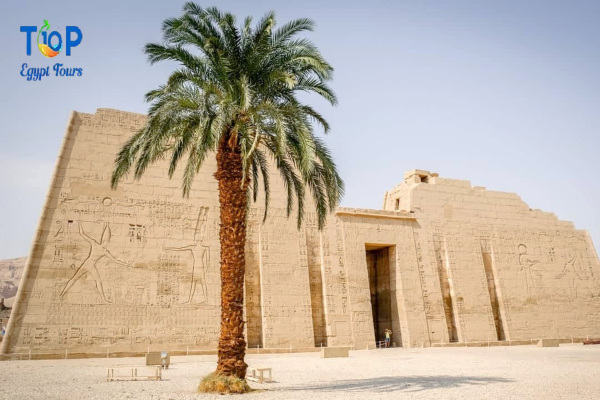Temple of Ramses III at Medinet Habu, Nestled on the west bank of the majestic Nile River in Luxor, Egypt, Medinet Habu stands as a testament to the grandeur of ancient Egyptian architecture and the glory of the New Kingdom period. Madinet Habu is one of the most impressive constructions in the west of Thebes. It covers an area of 320 m from east to west and 200 m from north to south.
In this article, we will uncover for you the Temple of Ramses III at Medinet Habu with Top Ten Egypt.
Historical Significance Of Temple of Ramses III at Medinet Habu:
Medinet Habu, also known as the Mortuary Temple of Ramesses III, is one of the most well-preserved structures on the west bank of Luxor. Built during the 12th century BCE, this temple complex served as a mortuary temple and a memorial to commemorate the reign of the powerful Pharaoh Ramesses III. The temple is surrounded by massive mud brick walls, adorned with intricate reliefs and hieroglyphics that depict scenes from Ramesses III’s military victories and religious rituals.
Architectural Marvels:
The architectural brilliance of Medinet Habu is awe-inspiring. The temple’s entrance is guarded by colossal statues of Ramesses III, and the first court is adorned with colossal statues of the pharaoh and depictions of divine offerings. The inner sanctum consists of a hypostyle hall with intricately carved columns, leading to various chambers dedicated to different deities and religious ceremonies. The vibrant colors of the well-preserved reliefs provide a vivid glimpse into the religious and cultural practices of ancient Egypt.
Ramses III, the last great ruler of the New Kingdom, built his temple in the second half of his reign.
His architecture built on enclosure walls included the temple of Hatshepsut and Thutmose III. He built 3 enclosure walls and the temple of Ramses III was the most completed temple in Egypt.
Now we are standing in front of the 2 towers and in between the Entrance.
In the entrance we always see the usual scene which is the king smiting his enemies.
The 2 towers usually have flags with yellow, red, white, green and black.
In the passage between the 2 towers of the great gate there are 2 seated statues of black granite for the Goddess Sekhmet as lioness headed woman.
The first hypostyle hall of the temple has more rooms, any room has a main function.
Religious Significance Of Medinet Habu:
Medinet Habu was not only a mortuary temple but also a place of worship and religious ceremonies. The complex is dedicated to the Theban Triad – Amun, Mut, and Khonsu – reflecting the religious beliefs and practices of the time. The temple played a crucial role in the pharaoh’s divine connections, and its walls are adorned with scenes depicting religious rituals, festivals, and offerings to the gods.
Exploring the Grounds:
As visitors walk through the sprawling complex of Medinet Habu, they can marvel at the well-preserved hieroglyphs and reliefs that narrate the stories of pharaonic power, military conquests, and religious devotion. The site includes not only the main temple but also the royal palace, a sacred lake, and various chapels dedicated to different deities. The impressive scale of the complex allows visitors to appreciate the significance of Medinet Habu in the ancient Egyptian world.
Medinet Habu stands as a remarkable testament to the grandeur of ancient Egypt, offering visitors a captivating journey through the religious, cultural, and military achievements of the New Kingdom period. As an integral part of the Egyptian Ancient Thebes cluster page, the Mortuary Temple of Ramesses III adds depth and context to the exploration of Luxor and Karnak Temples, making it a must-visit destination for those seeking to unravel the mysteries of Egypt’s glorious past.



Comment (0)